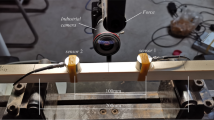Abstract
Understanding the failure mechanisms of construction materials, as well as their damage evolution, constitute two key factors to improving structural design tools. Depending on the failure modes to be highlighted and studied, several test methods and analysis tools have been developed. One such development, the acoustic emission technique (AET), is an experimental tool appropriate for characterizing material behavior by means of monitoring the fracture process. Despite the widespread uses of acoustic emission techniques to characterize and monitor the damage evolution of composite materials, only a few research studies have focused on using AET to characterize the mechanical behavior of wood materials. In the present work, the failure process in Douglas fir under monotonic loading is studied by comparing three experimental methods: force-displacement curve analysis, acoustic emission measurements, and digital image acquisition. First of all, results show good correlation and complementarities among the methods employed. Second, analyzing acoustic emission signals by considering the event number and the cumulative events yields interesting information on crack initiation and growth without the material. Moreover, an additional analysis of acoustic emission data (involving the determination of source locations and the study of amplitude distributions) opens the possibility to characterize the fracture process zone which is a key damage mechanism in wood materials.





















Similar content being viewed by others
References
Aicher S, Höfflin L, Dill-Langer G (2001) Damage evolution and acoustic emission of wood at tension perpendicular to fiber. Holz als Roh und Werkst 59:104–116
Ando K, Hirashima Y, Sugihara M et al (2006) Microscopic processes of shearing fracture of old wood, examined using the acoustic emission technique. Jpn Wood Res Soc 52:483–489
Berg J-E, Gradin PA (2000) Effect of temperature on fracture of spruce in compression, investigated by use of acoustic emission monitoring. J Pulp Pap Sci 26:294–299
Brunner AJ, Howald MT, Niemz P (2006) Acoustic emission rate behavior of laminated wood specimens under tensile loading. J Acoust Emiss 24:104–110
Chen Z, Gabbitas B, Hunt D (2006) Monitoring the fracture of wood in torsion using acoustic emission. J Mater Sci 41:3645–3655
Coureau JL, Morel S, Gustafsson PJ, Lespine C (2006) Influence of the fracture softening behaviour of wood on load-COD curve and R-curve. Mater Struct 40:97–106
Dubois F, Pop O, Husson JM, Sauvat N (2010) Thermodynamic approach about fracture modeling under mechano-sorptive loading, WCTE 2010, June 20–24, Riva Del Garda
Dubois F, Méité M, Pop O, Absi J (2012) Characterization of timber fracture using the digital image correlation technique and finite element method. Eng Fract Mech 96:107–121
Gonzalez RC, Woods RE, Masters BR (2009) Digital image processing. Third edition. J Biomed Opt 14:976
Grosse C, Ohtsu M (2008) Acoustic emission testing in engineering—Basics and applications. Springer, Heidelberg, p 404
Kawamoto S, Williams RS (2002) Acoustic emission and acousto-ultrasonic techniques for wood and wood-based composites, A review, Forest Product Laboratory, p 16
Landis EN, Whittaker DB (2000) Acoustic emissions and the fracture energy of wood. In: Ansari F (ed) Condition monitoring of materials and structures. ASCE, Reston, pp 21–29
Morel S, Dourado N, Valentin G (2005) Wood: a quasibrittle material R-curve behavior and peak load evaluation. Int J Fract 131:385–400
Muravin B (2009) Acoustic emission science and technology. J Build Infrastruct Eng Isr Assoc Eng Archit. Israel
Ohuchi T, Hermawan A, Fujimoto N (2011) Basic studies on fracture toughness of Sugi and acoustic emission. J Fac Agric 1:99–102
Pop O, Meite M, Dubois F, Absi J (2011) Identification algorithm for fracture parameters by combining DIC and FEM approaches. Int J Fract 170:101–114
Reiterer A, Stanzl-Tschegg SE, Tschegg EK (2000) Mode I fracture and acoustic emission of softwood and hardwood. Wood Sci Technol 34:417–430
Réthoré J, Roux S, Hild F (2009) An extended and integrated digital image correlation technique applied to the analysis of fractured samples. Eur J Comput Mech 18:285–306
Svobodova E, Svoboda V (2012) Possibilities of acoustic emission method for evaluation of characteristic processes in wood. In: 30th European conference on acoustic emission testing & 7th international conference on acoustic emission, pp 1–9
Varner D, Cerny M, Varner M, Fajman M (2012) Possible sources of acoustic emission during static bending test of wood specimen. ACTA Univ Agric Mendelianae Brun LX:199–206
Author information
Authors and Affiliations
Corresponding author
Rights and permissions
About this article
Cite this article
Lamy, F., Takarli, M., Angellier, N. et al. Acoustic emission technique for fracture analysis in wood materials. Int J Fract 192, 57–70 (2015). https://doi.org/10.1007/s10704-014-9985-x
Received:
Accepted:
Published:
Issue Date:
DOI: https://doi.org/10.1007/s10704-014-9985-x




